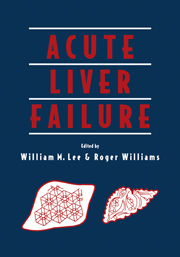Book contents
- Frontmatter
- Contents
- Preface
- Foreword
- Acknowledgments
- Contributors
- Part One Clinical Syndrome and Etiology
- 1 Classification and clinical syndromes of acute liver failure
- 2 Viral hepatitis and acute liver failure
- 3 Drug hepatoxicity as a cause of acute liver failure
- 4 Acetaminophen-induced acute liver failure
- 5 Unusual causes of acute liver failure
- 6 Pediatric aspects of acute liver failure
- Part Two Mechanisms of Disease and Multisystem Involvement
- Part Three Intensive Care Management
- Part Four Transplantation
- Part Five Artificial and Bioartificial Liver Devices
- Part Six Other Applications
- Index
- Plate section
4 - Acetaminophen-induced acute liver failure
from Part One - Clinical Syndrome and Etiology
Published online by Cambridge University Press: 20 May 2010
- Frontmatter
- Contents
- Preface
- Foreword
- Acknowledgments
- Contributors
- Part One Clinical Syndrome and Etiology
- 1 Classification and clinical syndromes of acute liver failure
- 2 Viral hepatitis and acute liver failure
- 3 Drug hepatoxicity as a cause of acute liver failure
- 4 Acetaminophen-induced acute liver failure
- 5 Unusual causes of acute liver failure
- 6 Pediatric aspects of acute liver failure
- Part Two Mechanisms of Disease and Multisystem Involvement
- Part Three Intensive Care Management
- Part Four Transplantation
- Part Five Artificial and Bioartificial Liver Devices
- Part Six Other Applications
- Index
- Plate section
Summary
INTRODUCTION
Acetaminophen (paracetamol; N-acetyl-paminophenol), a para-aminophenol derivative, is an active metabolite of both acetanilide and phenacetin. Acetanilide, the parent compound, was first introduced as an antipyretic and analgesic in 1886 but its use was limited by its toxicity. Consequently other para-aminophenol derivatives were tested which led to the introduction of phenacetin in 1887 followed by acetaminophen in 1893, which was first used in medicine by von Mering (Insel 1990). In the USA, acetaminophen has been available since 1952 and in the UK it has steadily gained in popularity as an analgesic from 1956 onwards. It is available without prescription and, when used at the recommended dosage, has few side effects and is considered safer than aspirin (Lancer 1981). Currently, in the UK and USA, there are more than one hundred proprietary preparations of acetaminophen, and more than two hundred proprietary multi-ingredient acetaminophen preparations.
The hepatotoxic effects of acetaminophen were first reported by Eder in 1964, during long-term toxicity studies in cats (Eder 1964), and two years later extensive centrilobular necrosis was observed in rats given high doses of acetaminophen (Boyd and Bereczky 1966). The first cases of severe and fatal liver damage in man following acetaminophen overdose were reported in the UK in the same year (Davidson and Eastham 1966; Thomson and Prescott 1966).
INCIDENCE
Acetaminophen overdose, with deliberate suicidal intent, is increasing in most Western countries. In the USA during 1987 there were 60,000 calls to Poison Control Centers concerning acetaminophen overdoses (Smilkstein et al. 1988) and in 1993 over 90,000 were recorded, although in the same year only 92 deaths were directly related to overdose of acetaminophen (Litovitz et al. 1994).
- Type
- Chapter
- Information
- Acute Liver Failure , pp. 32 - 42Publisher: Cambridge University PressPrint publication year: 1996
- 1
- Cited by



